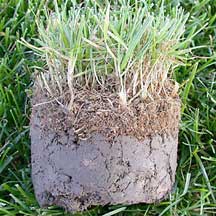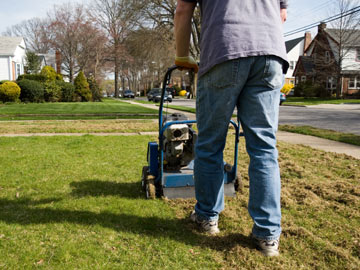 Proper lawn care eliminates thatch.
Proper lawn care eliminates thatch.
© Purdue University
Dethatching a lawn isn’t something to be taken lightly. Most consider it a chore, involving a little elbow grease or even special equipment rental, but the payback can be enormous in improving the health of your lawn. For small lawns a thatch rake can be used to remove thatch from grass; for larger lawns, consider renting a power rake to remove thatch. Also, remember a certain amount of thatch is necessary to the health of your lawn. So how do you know when enough is enough?
Here are the answers to the five most commonly asked questions about dethatching your lawn.
1. What is thatch?
It’s a normal part of your lawn’s growth. The grass plant has an above ground plant – the grass you can see – and a root system below the ground. In between, there are bits of dead grass and other natural debris. That’s the thatch, and it forms a protective layer above the soil, in most cases keeping your grass stronger and helping to seal in moisture.
 Dethatching a lawn.
Dethatching a lawn.
2. How much is too much?
For most lawns, the optimal amount of thatch is ¼–½ inch. Any thicker, and it can actually hamper growth – preventing air, water and nutrients from penetrating to the roots. It also creates an environment for pests and disease to flourish. You can check the thickness of your lawn’s thatch by digging out a small plug to examine the layers.
3. How do I remove thatch?
Removing the thatch from your lawn is called dethatching, and can be done with a special rake, or for larger, more thickly thatched lawns, a special machine that can be rented from your local lawn and garden center.
4. When is the best time to dethatch?
In most U.S. climates, late spring is the best time to dethatch because it gives your lawn plenty of time to grow and recover. Spring temperatures also tend to be moderate, which can also be important to your lawn’s recovery.
5. How often will I have to dethatch?
Thatch buildup is largely specific to the type of grass you grow. Grasses that grow during the warmer season, like Buffalo grass or Bermuda grass varieties, tend to build up more thatch. In the long run, it’s better to dethatch before it gets too thick, so you may want to consider doing it every year to minimize the trauma of a deep dethatching.
When done dethatching, don’t forget to finish your lawn revitalization by spreading grass seed such as GreenView Fairway Formula Sun & Shade Grass Seed Mixture across lawn and raking it into the grass – it’s great seed for sunny and slightly shaded areas. GreenView grass seeds feature top-rated proprietary seed varieties that are 99% weed free! Then, use a lawn spreader to apply GreenView Starter Fertilizer with GreenSmart. This product is specially formulated to encourage root growth and establishment of newly-seeded lawns. The 10-18-10 ratio of nutrients and phosphorus content is an analysis that promotes new seed establishment.
Give the lawn a thorough watering – and you’re well on your way to a healthier lawn this spring!